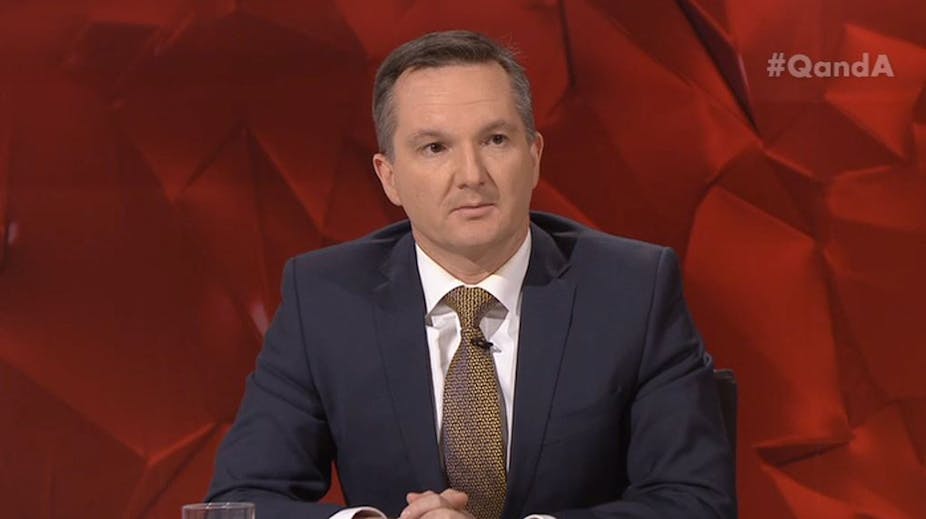The Conversation is fact-checking claims made on Q&A, broadcast Mondays on the ABC at 9:35pm. Thank you to everyone who sent us quotes for checking. Viewers can request statements to be FactChecked via Twitter using hashtags #FactCheck and #QandA, on Facebook or by email.
The fact of the matter is if you increase the GST, you have to spend close to 60% on compensation and then you’ve only got 40% of what you’ve raised left and it doesn’t go very far. – Shadow Treasurer, Chris Bowen, speaking on Q&A, September 7, 2015.
NSW Premier Mike Baird has called for the Federal Government to raise the goods and services tax (GST) rate from 10% to 15% to help pay for health care and other costs, but his proposal has been met with resistance from the ALP.
Speaking on Q&A, federal shadow treasurer Chris Bowen said close to 60% of any revenue raised through the GST would have to be spent on compensation. Is that accurate?
No legal requirement
From a legal perspective, the simple answer is no.
There is nothing that legally requires the government to provide compensation (of any amount) if the GST is increased.
However, from a political point of view, in order to obtain support for any GST rate rise, the government would likely offer compensation through income tax cuts and increased social security payments.
When asked for a source for the 60% figure, a spokesman for Bowen referred to comments by NSW Premier Mike Baird. Bowen’s spokesman said:
I think the best reference point is from the architect of increasing the GST to 15%. Here, Mike Baird on ABC 7.30 clearly outlines the revenue raise/amounts he would consider for compensation. If you take A$18 billion over $32 billion, Mike’s reasoning, then you get 56%.
The spokesman referred to the following exchange between Baird and 7.30 presenter Leigh Sales:
LEIGH SALES: But then how much would that cost you out of the revenue that you would hope to raise by increasing the GST?
MIKE BAIRD: I mean, it’s - it depends on how much you pay. I mean, my proposal, as I said, for those 60% of households which are under A$100,000 and then 50% from $100,000 to $155,000, that’s the package at the moment, effectively you’d get from $32 billion down to about $15 or $16. So it’s $17 or $18 billion worth in terms of the compensation payments.
In a previous opinion piece for The Australian, Mike Baird wrote:
Our expectation is that a package can be designed with compensation to ensure households earning up to $100,000 are not disadvantaged.
As a regressive tax, the GST disproportionately affects those on low incomes. Careful thought would therefore have to be given to how such a compensation package would be designed. Income tax cuts, for example, would also benefit high income households.
While the possibility of increasing the GST is currently being discussed, there have been no formal proposals put forward in terms of how a compensation package would be designed and implemented.
Further, even if compensation is offered, not all states are likely to agree to a GST rate rise. For example, the Victorian Treasurer Tim Pallas has said he would veto any proposals to raise the GST, referring to the possibility of a compensation package as “just putting lipstick on a pig”.
Legally, while the federal government can change the GST without the support of the states, it would be unlikely to do so.
Verdict
It is not correct from a legal perspective to say that the government would have to spend close to 60% of any GST revenue raised on compensation. However, the government would likely offer compensation to accompany a GST increase.
The amount of compensation offered would be subject to more formal government modelling and debate. There is no formal proposal on the table pegging the compensation amount at 60% of GST revenue raised or any other specific figure.
Review
There is no legal or generally agreed political requirement to compensate for an increase in the GST.
The political answer varies with the revenue, efficiency and equity objectives of the tax reform, and with the specific design of a tax reform package which includes a larger GST.
The NSW premier, Mike Baird, proposes to raise the GST rate from 10 to 15% to fund projected increases in government expenditure on health care.
Since low and middle income people, as well as high income people, benefit from higher expenditure on health care, it could be argued that all households may be expected to contribute extra taxation.
True, a higher rate GST is more regressive than a higher income tax rate, or a higher Medicare levy rate.
The government could even consider no income tax reduction or social security increases if the higher GST were to replace more distorting indirect taxes, such as state stamp duties.
On the other hand, if the larger GST was part of a lower income tax and higher consumption tax mix reform package, all of the extra GST revenue would likely be recycled to households. – John Freebairn

